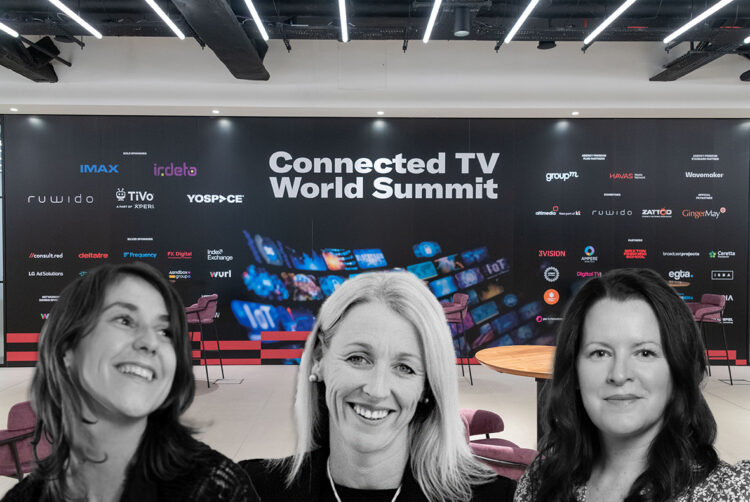Rival alliances, cultural POVs, data ownership: Key themes in TV

The Media Leader invited some of the Top 50 Women Gamechangers in TV to attend Connected TV World Summit last month and share their thoughts on the key talking points and predictions from the event.
Reporting back their findings were Ruth Cartwright, head of investment at Sky Media; Alessia Clusini, co-founder of Trybes; and Angela Goodsir, director at Thinkly.
What was your number one key takeaway from Connected TV World Summit 2024?
Clusini said: “From an audience perspective, TV’s future is bright. From quality and quantity of content to convenient solutions and personalised ads, audiences can get what they want, when and where they want it and at the price they are willing to pay.”
Change was top of the agenda for Cartwright. “We may not have all the answers right now, but we’re all focused on customers, innovation, content and experience — with an eye on what that means for the industry now and in the future,” she explained.
For Goodsir, since “competition is fierce”, the landscape “requires new perspectives, including consideration of competitors as potential allies and partners”. She continued: “Key players are now taking ownership and control over the whole supply chain and revenue pipeline, and forming data alliances to build out complete customer journeys.”
If there was one session you would recommend people watch on catch-up, which would it be?
Goodsir thought “‘P2F’ – the next market evolution in online video” with Maria Rua Aguete at Omdia provided a great overview.
She said: “Maria’s session provided great insights, data trends and a summary around the bundling of subscription VOD (SVOD), the importance of partnerships and alliances, eg. telcos and streaming services, and the acceleration of advertising and ad-centric services for SVOD services.”
Both Clusini and Cartwright pointed to “The next steps in cross-platform audience measurement”. “I confess to being baffled at times with the many measurement routes, so I appreciate it when there’s clear expertise,” Cartwright admitted.
“I wish we could go further into audience measurement and talk about how to deeply understand audiences beyond numbers — not just what they are watching, but also why and how their worldviews and cultures can be intercepted by great TV,” Clusini added. “I feel we still treat them as eyeballs and not people. There’s a huge opportunity for industry players to do this.”
Who was your favourite speaker and why?
Clusini chose two: Faz Aftab, Google’s director of international media and entertainment partnerships, for her “pragmatic way of tackling industry problems”; and Alice Baines, media planning and business director at OMD UK, “who best addressed the value of meeting viewers where they are, considering their lifestyles and cultural POV”.
Matthew Bailey, advertising research lead at Omdia, was the top speaker for both Goodsir and Cartwright. Goodsir said: “Matthew provided a clear summary of retailers and connected TV manufacturer synergies and an overview of the new power players.”
Bailey’s discussion of US developments were of particular interest to Cartwright. She noted: “I always have an eye on where the market is innovating: clear focus on partnerships that are delivering measurement and improving ad targeting. I’m interested in the connections being made and how this will translate to the UK.”
What was the most inspiring and insightful comment of the day?
For Cartwright, due to the complexity of content, “our role as an industry is to make this choice easy to navigate and consume”.
On the same theme of the breadth of content available, Clusini overheard an insightful thought: “A great innovation opportunity lies in the lack of a clear route for discovery, findability and content surfacing.”
Goodsir, meanwhile, highlighted Thierry Fautier’s exclamation during his panel on the operating system “battlefield”: “Transform or die.” She said: “We are part of an industry that urgently requires revolutionary change. Thierry makes it pretty clear what needs to be done.”
Based on what you heard at the event, what do you predict to be the main talking points at Connected TV World Summit 2025?
Cartwright predicts that 2025 will be all about “winners and losers in FAST”, adding: “There is and will continue to be quick growth in this area.” In addition, measurement and data will still dominate TV conversations: “Access and ownership — who has it, who wants it.”
Clusini believes AI remains key. “I spoke with many people who enjoyed how Maria Ingold explained AI as related to media and how it can save them money. I think we need to add to these great points the threat and opportunity of AI lowering barriers to content production and becoming an important player in content distribution,” she said. “We are facing a future where audiences’ consumption of TV will be hugely intermediated by AI curation. Young generations are already there. What are we doing about it?”
Goodsir, meanwhile, pointed to a number of predictions. First and foremost, emerging technology will play a role in the creation of new ad experiences and models.
Secondly, with the acceleration of change in the industry, “creativity, real innovation and emerging technologies need to be at the core and centre of our strategies”. Related to that, she added: “We have to do more with less, so again we need to accelerate and automate the back-end processes and workflows towards a sustainable future.”
From a broader perspective, “we need to keep modernising our thinking on data and measurement”, while “aggregation in all its forms” will become increasingly crucial.
Finally, she noted: “Sustainability will continue to get more airplay.”
All of the talks at Connected TV World Summit 2024 are now available to view on Adwanted UK’s YouTube channel.




